Euskal Oiloa
The Euskal Oiloa, Spanish: Gallina Vasca, is a breed of domestic chicken from the autonomous community of the Basque Country in north-eastern Spain and south-western France. It is the traditional rural chicken of the area, a rustic dual-purpose breed of Atlantic type, and differs from Mediterranean Spanish breeds such as the Castellana Negra and the Minorca in several respects: it has yellow legs and feet, red earlobes, and lays brown eggs.[1]
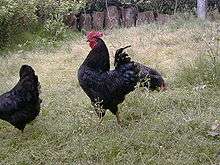 The Beltza variety | |
| Other names | Spanish: Gallina Vasca |
|---|---|
| Country of origin | Spain |
| Standard | MAGRAMA (in Spanish) |
| Traits | |
| Weight | |
| Egg color | brown |
| Comb type | single |
| Classification | |
| APA | no[2] |
| EE | France, Spain[3] |
| PCGB | no[4] |
| Notes | |
| yellow legs, red earlobes | |
| |
History
The Euskal Oiloa is the traditional chicken of the Basque rural economy. It was distributed throughout the historical territories of Araba, Bizkaia and Gipuzkoa, and gave both meat and brown eggs. In the twentieth century it was at first not threatened by imported commercial hybrid layer chickens and the spread of highly intensive chicken farming methods, as breeds such as the Leghorn laid white eggs, while Basque consumers preferred brown. Later, when brown-egg commercial hybrids appeared, they began to displace the traditional breed in many households.
Selective breeding of the Euskal Oiloa was begun in 1975 as part of the conservation programme for indigenous chicken breeds of the Instituto Nacional de Investigación y Tecnología Agraria y Alimentaria, the national public agrarian research institute.[5] The decision to seek official breed status for these birds was taken at that time.[6] A breed association, the Asociación de Criadores de Razas Aviares Vascas or EOALAK, was founded in 2006.[7]
The breed standard of the Euskal Oiloa was officially approved on 15 March 2001.[8] It is included in the official list of indigenous Spanish breeds in the royal decree of 26 December 2008, which established the national livestock breed conservation programme, where it is listed among the indigenous breeds at risk of extinction.[9] At the end of 2013 a population of 10,872 birds was reported, all from the País Vasco.[10]
Characteristics
The Euskal Oiloa is a medium-heavy breed: cocks weigh about 3.6 kg, hens about 2.5 kg.[1] The comb is single, with five to seven well-defined points. The comb, face, wattles and earlobes are red; the earlobes are narrow and pointed. The beak is curved in the cock, less so in the hen. The legs, feet and skin are yellow.[8]
Five colour varieties are recognized: Beltza (black), Gorria (red), Lepasoila (naked-necked, red-brown), Marraduna (golden cuckoo) and Zilarra (black-tailed white). The Lepasoila, like other naked-necked chickens, has red skin on the neck.[8][11]
Use
Euskal Oiloa hens lay 209–220 brown eggs[11] weighing about 60 g per year.[8] Much of the meat production is in the form of capons; chemical castration is not used. In 2008 the Euskal Oiloa was added to the Slow Food Ark of Taste.[7][11]
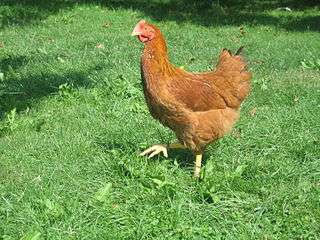 The Gorria variety
The Gorria variety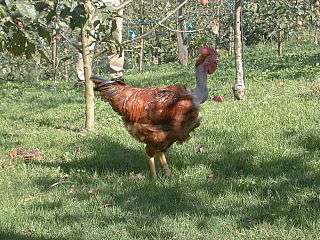 The Lepasoila variety
The Lepasoila variety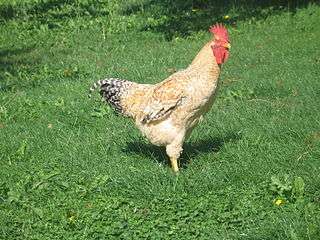 The Marraduna variety
The Marraduna variety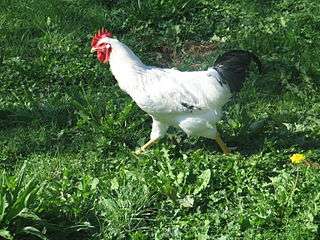 The Zilarra variety
The Zilarra variety
References
- Miguel Fernández Rodríguez, Mariano Gómez Fernández, Juan Vicente Delgado Bermejo, Silvia Adán Belmonte, Miguel Jiménez Cabras (eds.) (2009). Guía de campo de las razas autóctonas españolas (in Spanish). Madrid: Ministerio de Medio Ambiente y Medio Rural y Marino. ISBN 9788449109461. p. 632–634.
- APA Recognized Breeds and Varieties: As of January 1, 2012. American Poultry Association. Archived 4 November 2017.
- Liste des races et variétés homologuée dans les pays EE (28.04.2013). Entente Européenne d’Aviculture et de Cuniculture. Archived 16 June 2013.
- Breed Classification. Poultry Club of Great Britain. Archived 12 June 2018.
- José Luis Campo Chavarri (2010). Razas españolas de gallinas. El programa de conservación del INIA (1975–2010) (in Spanish). Madrid: Instituto Nacional de Investigación y Tecnología Agraria y Alimentaria. doi:10.1017/S2078633612000215
- Fernando Orozco, José Luis Campo (January 1981). Desarrollo del programa de conservación de razas españolas de gallinas (in Spanish). Selecciones avícolas 23 (1): 3–7.
- Estándar Euskal Oiloa (in Spanish). Asociación de Criadores de Razas Aviares Vascas = Euskal Oilo eta Antzarren Hazitzaileen Elkartea. Accessed September 2014.
- ORDEN de 15 de marzo de 2001, del Consejero de Agricultura y Pesca, por la que se aprueba la reglamentación específica de la raza aviar 'Euskal Oiloa' (in Spanish). Boletín Oficial del País Vasco 54 (16 March 2001): 5233–39.
- Real Decreto 2129/2008, de 26 de diciembre, por el que se establece el Programa nacional de conservación, mejora y fomento de las razas ganaderas (in Spanish). Boletín Oficial del Estado 23 (27 January 2009): I: 9211.
- Raza aviar EUSKAL OILOA: Datos Censales (in Spanish). Ministerio de Agricultura, Alimentación y Medio Ambiente. Accessed September 2014.
- Ark of Taste: Basque Chicken Euskal Oiloa. Slow Food Foundation for Biodiversity. Accessed September 2014.